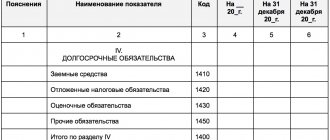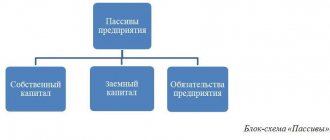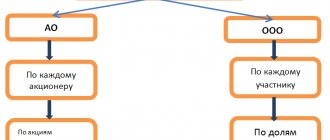This line of the Balance Sheet reflects information about fixed assets (fixed assets) recorded in accounting on account 01 “Fixed Assets”. On the issue of reflecting in the Balance Sheet unfinished capital investments accounted for in account 08 “Investments in non-current assets” (except for subaccounts 08-5 and 08-8), there are currently two positions.
The first position is that the amount of unfinished capital investments in objects that will subsequently be accepted for accounting on account 01 is included in the indicator of line 1150 and is reflected separately on one of the lines deciphering the indicator of this line. This position is based on the fact that in the form of the Balance Sheet, approved by Order of the Ministry of Finance of Russia dated July 2, 2010 N 66n, there is no separate line “Construction in progress”. At the same time, according to paragraph.
20 PBU 4/99, the article “Construction in progress” is included in the group of articles “Fixed assets”, and clause 3 of Order of the Ministry of Finance of Russia dated July 2, 2010 N 66n allows organizations to independently determine the detail of indicators for reporting items. In addition, Appendix No. 3 to Order of the Ministry of Finance of Russia dated July 2, 2010 No. 66n provides an example of the preparation of Explanations to the Balance Sheet and the Statement of Financial Results. In this Example, Sect.
Work in progress in the balance sheet: line
2 “Fixed assets” includes table 2.2 “Unfinished capital investments”.
The second position is that information about unfinished capital investments is not reflected in line 1150 “Fixed assets”. This conclusion follows from the norms of PBU 6/01 (later than the above-mentioned PBU 4/99). In particular, the requirements for the disclosure of information about fixed assets in the financial statements are established by clause 32 of PBU 6/01, which does not contain any mention of unfinished capital investments or unfinished construction. In addition, PBU 6/01 “Fixed assets” itself does not apply to capital investments, since they do not meet the conditions for acceptance for accounting as part of fixed assets (clauses 3, 4 of PBU 6/01). An additional argument in favor of this position is that in the Regulations on Accounting and Financial Reporting in the Russian Federation, in the section “Rules for the evaluation of items in financial statements”, the subsection “Unfinished capital investments” is present along with the subsection “Fixed assets”.
Thus, organizations will have to independently, taking into account the above arguments, decide whether to include the amount of unfinished capital investments in the indicator of line 1150 “Fixed assets” or not. In the latter case, the amount of unfinished capital investments can be reflected in Section. I “Non-current assets” according to a separate line “Unfinished capital investments” independently entered by the organization, and if the indicator is not significant - according to line 1190 “Other non-current assets” (on the issue of disclosing data on in-progress capital investments, see also Letter of the Ministry of Finance of Russia dated January 27, 2012 N 07-02-18/01).
Let us note that when deciding on the reflection of incomplete capital investments in the Balance Sheet, it is advisable to apply a unified approach to reflecting all types of investments in non-current assets.
ADDITIONALLY on this issue, see Letter of the Ministry of Finance of Russia dated December 6, 2011 N 03-05-05-01/95.
Accounting and taxation of construction in progress
Accounting and taxation of organizations involved in construction, construction and sale of apartments, investment in the field of construction raise questions related not only to the reflection of these transactions in accounting accounts, but also to taxation.
The procedure for recording transactions and taxation of transactions is regulated by the following main documents:
Regulations on accounting of long-term investments, approved by Letter of the Ministry of Finance of Russia dated December 30, 1993 N 160;
Order of the Ministry of Finance of Russia dated December 20, 1994 N 167 “On approval of the Accounting Regulations “Accounting for Agreements (Contracts) for Capital Construction” (PBU 2/94)”;
Standard methodological recommendations for planning and accounting for the cost of construction work, approved by the Ministry of Construction of Russia on December 4, 1995 N BE-11-260/7 (as amended on August 14, 1997), communicated by the Letter of the Ministry of Finance of Russia dated January 15, 1996 N 2 (hereinafter referred to as the Standard Methodological Recommendations recommendations);
Law of the Russian Federation dated December 6, 1991 N 1992-1 “On Value Added Tax” (with subsequent amendments and additions);
Instruction of the State Tax Service of Russia dated October 11, 1995 N 39 “On the procedure for calculating and paying value added tax” (with subsequent amendments and additions);
Law of the Russian Federation of December 27, 1991 N 2116-1 “On income tax of enterprises and organizations” (with subsequent amendments and additions);
Instruction of the State Tax Service of Russia dated August 10, 1995 N 37 “On the procedure for calculating and paying income tax for enterprises and organizations to the budget” (with subsequent amendments and additions).
In accordance with the Standard Methodological Recommendations, construction work in progress includes unfinished work in organizations, their queues, start-up complexes and objects that are objects of cost accounting. Work in progress consists of the costs of construction work performed in-house, as well as the cost of work of subcontractors accepted and paid by general contractors for the period from the beginning of the construction contract.
The actual cost of construction work performed on its own is accounted for in a separate subaccount of the “Main Production” account and is determined by the total cost of the construction organization for such work.
2.22: Which MySQL line contains the maximum value for a group?
Home Page » Books on PHP » MySQL lessons for beginners from scratch » Which line contains the maximum value for a group
For each item, find the sales agent with the highest price.
The easiest way to achieve this effect in MySQL is this:
- Get a list of records (product, maximum price).
- For each product, obtain from the table the corresponding rows that have the maximum price.
This can be easily done through a temporary table that is only needed to store the intermediate data set. This is a rather complex sequence of actions, so let's look at it step by step. First create a temporary table in the database:
As you can see, there are only two columns in the temporary table: one for the product code (article), the other for the price (price). The TEMPORARY keyword means a table that is temporarily created to store intermediate data.
Now we need to follow this difficult moment. The fact is that MySQL is a multi-user system. This means that while you are working with the table, someone else can be working with it (there can be any number of such “someone else”). You don’t know anything about each other, nor about who is doing what with the table. You don't need to know this.
But here’s the problem: what will happen if, at the moment when you get data from the table for your analysis, someone takes it and changes it? This will not lead to anything terrible, but you will receive outdated data and you will not see any changes. This means that you must prevent changes from being made until you complete the calculations. This is done using blocking.
Elimination of “unfinished work”...
According to clause 63 of PBU approved. By order of the Ministry of Finance of the Russian Federation dated July 29, 1998 No. 34n, work in progress (WIP) is products (work, services) that have not gone through all stages of the production cycle during the reporting period. This also includes products or components that did not pass quality control or were rejected by the customer.
But here’s the problem: what will happen if, at the moment when you get data from the table for your analysis, someone takes it and changes it? This will not lead to anything terrible, but you will receive outdated data and you will not see any changes. This means that you must prevent changes from being made until you complete the calculations. This is done using blocking.
As of the reporting date, the organization may have products or work that have not passed all stages (phases, conversions) provided for by the technological process, or incomplete products that have not passed testing and technical acceptance. In other words, the organization may still have work in progress (WIP) (clause 63 of Order of the Ministry of Finance dated July 29, 1998 No. 34n).
At the construction stage, all costs associated with construction are investments in non-current assets.
This account is active, all expenses are carried out by debit turnover. At the time the facility is put into operation after completion of construction and installation procedures, the accumulated amount will be the initial cost of the fixed asset, it is written off from the credit of account 08.
In this Example, Sect. 2 “Fixed assets” includes table 2.2 “Unfinished capital investments”. The second position is that information about unfinished capital investments is not reflected in line 1150 “Fixed assets”. This conclusion follows from the norms of PBU 6/01 (later than the above-mentioned PBU 4/99).
Construction in progress is the actual costs incurred for unfinished and not put into operation objects. For the purposes of transactions, the seller is required to have a certificate of title to the “unfinished” property.
Sales of unfinished construction projects are subject to VAT at a rate of 18%. Therefore, if the purchase and sale agreement specifies the price of an unfinished construction project (without indicating VAT), the seller cannot require the buyer to pay tax in excess of the contract price. In this case, VAT is included in the price established by the parties (Resolution of the Federal Antimonopoly Service ZSO dated September 29, 2008 N F04-6043/2008(12901-A75-24)).
Obviously, in this case, the accountant must be guided by Art. 268 of the Tax Code of the Russian Federation, according to which, when selling other property, the taxpayer has the right to reduce the income received by the price of its acquisition (creation), as well as by the amount of expenses directly related to such sale (for example, valuation costs).
Unfinished construction may mean costs associated with the construction of industrial buildings and all kinds of structures, as well as costs of geological and engineering work, the purchase of equipment to equip premises with the necessary capacities, and installation costs. All these expenses also apply to unfinished work, although they can be allocated separately.
The purchase of equipment for a fee from other organizations and persons is reflected in the debit of account 07 “Equipment for installation” in correspondence with account 60 “Settlements with suppliers and contractors” or others; accepted as a contribution to the authorized (share) capital of the organization - in correspondence with the credit of account 75 “Settlements with founders”.
Tax authorities have repeatedly pointed out that in order to define this concept, by virtue of paragraph 1 of Art. 11 of the Tax Code of the Russian Federation, it is necessary to be guided by the corresponding explanations of Rosstat (see, for example, letters of the Ministry of Taxes of Russia dated March 24, 2004 N 03-1-08/819/16, Federal Tax Service for Moscow dated January 31, 2007 N 19-11/8073, dated February 25. 2005 N 19-11/11713).
This type of audit is of greater interest to contractors. The third type of audit is final.
At the time of reporting, the organization may still have unfinished work or various products that have not gone through all stages of processing. All these cases relate to work in progress and are also reflected in the reporting. There is a special line for work in progress in the balance sheet, where the necessary information is entered when drawing up documentation.
Classify commercial property by functional role and composition, and by sources of formation.
Before freezing construction at the site, an inventory is carried out. For this procedure, a commission body is created from representatives of the customer and the contractor. After inspecting the unfinished structure, members of the commission draw up an inventory list. The document reflects:
- name of the property;
- list of structural elements;
- construction stage.
It is worth considering that if an organization has the right to maintain simplified accounting, then it does not have to generate reports on work in progress; in this case, such information may not be indicated.
Organizations that can use the simplified reporting method include representatives of small businesses, as well as non-profit structures and some other companies.
In addition, PBU 6/01 “Fixed assets” itself does not apply to capital investments, since they do not meet the conditions for acceptance for accounting as part of fixed assets (clauses 3, 4 of PBU 6/01).
In accounting for enterprises that are not part of public sector business entities, the following standard correspondence for accounting for unfinished construction projects can be used:
- The acquisition of unfinished property is reflected in accounting by placing the object on the balance sheet and reflecting the debt to the seller - D08.3 - K60. The same entry also shows the costs of paying for the services of third-party organizations entrusted with completing construction and putting the asset into operation.
- D01 - K08.3 - work in progress in construction in accounting passes to the status of completed, the facility is put into operation. This operation is carried out if there is a certificate of verification of the readiness of the object.
lines 1150 and 1190 balance
The topic of locking is vast and complex, and is therefore covered in subsequent chapters.
But now let's look at the simplest option. So, we need to lock the shop table. We don't need to make the table completely inaccessible. It is only necessary that no one can make changes to it. But other users will be able to read the table. Let's get started:
If you are not using the TEMPORARY table, you must also lock the tmp table.
The read word in this command means that you have allowed other server users to read the table. This is where the concept of flow can lead to misunderstandings. The fact is that the table lock applies to all threads, except for the one that created the lock.
It would seem: so what? Here's what: if you have opened several copies of the client and established more than one connection to the server, then the table lock will spread to all your connections, excluding the one in which you set the lock. Accordingly, you can only remove the blocking in the same connection.
It doesn't matter that you logged into the server under the same login in all connections. The important thing is that the blocking is tied to a specific connection, not to the user. This situation often leads novice users to make a mistake: they lock one connection and try to unlock it from another. It won't work, the server won't allow it.
Now comes the reason why we blocked the table. Let’s select the necessary data from it and fill the prepared temporary table with it:
As you can see, another tricky trick is used here. Instead of listing the input values in the INSERT statement (using the word VALUES), we substituted the SELECT statement directly in their place. What will happen? Here's the thing: the SELECT statement will find and return the rows, but instead of displaying them on the screen, they will go straight into the INSERT statement, which will insert them into the tmp table. Thus, one query can be nested within another (here SELECT is nested within INSERT). Please take note for later use.
Now let's find the maximum price. The query uses two tables (shop and tmp), and if so, then the column names are used indicating the table from which data should be retrieved:
Great, data received. Now let’s give other users the opportunity to work with the locked table in full (and not just read it):
This command will release any locks held by the current thread from any tables you have locked. We will talk more about locks later (and a lot: the topic is complex), but for now we will delete the temporary table with all the data in it that has become superfluous:
The DROP command is designed to remove something. Because the table needs to be dropped now, the TABLE keyword is specified, followed by its name. Actually learn English! SQL differs from programming languages precisely in that you work with it, albeit in a very simplified, but quite understandable English language. Most of the words are the same. The DROP command will be discussed in more detail later, in Chapter 7, where operations with tables are discussed.
Could all this be done in a single request?
Yes, but only using the completely ineffective MAX-CON cat technique, which is provided for reference purposes only:
Share with friends
Unfinished construction and equity holders’ funds: how best to show it on the balance sheet
“Construction in progress” refers to the amount of unfinished capital investments. These are expenses for unfinished construction and installation work and other capital works and expenses (design and survey, geological exploration and drilling work, costs of land acquisition and resettlement associated with construction, costs of forming the main herd of productive and working livestock, etc.). d.). In addition, line 130 reflects the costs of acquiring intangible assets and fixed assets that require and do not require installation before their commissioning. Line 130 indicates the amount of costs for work performed both on-site and by contract. Unfinished capital investments are reflected in the balance sheet at actual costs for the developer (investor).
If, according to the accounting policy, the organization does not transfer constructed or acquired real estate to account 01 “Fixed Assets” before receiving documents confirming state registration of ownership, but continues to account for them in a separate subaccount of account 08 “Investments in non-current assets”, then the cost of these real estate objects should also be reflected on line 130.
Please note: for real estate objects for which capital construction has been completed, an acceptance certificate has been drawn up, documents have been submitted for state registration of ownership rights and which are actually operated by the organization, depreciation should be calculated in the generally established manner. Moreover, regardless of which account – 01 “Fixed Assets” or 08 “Investments in Non-Current Assets” – these real estate items are recorded. This requirement is established by paragraph 52 of the Methodological Instructions for Accounting for Fixed Assets. Therefore, when drawing up a balance sheet, the value of such real estate items accounted for on account 08 should be reflected minus the amounts of depreciation accrued on these items on account 02.
The line 130 indicator is formed as the sum of the debit balances of the accounts:
- 07 “Equipment for installation”;
- 08 “Investments in non-current assets”;
- 16 “Deviations in the cost of material assets” (in terms of deviations related to property, the cost of which is reflected in accounts 07 and 08).
Please note: on line 130 of the balance sheet, the amounts of advances transferred to suppliers and contractors cannot be reflected as part of the costs of construction in progress. According to paragraph 3 of PBU 10/99 “Expenses of the organization”, amounts of advances and prepayments are not recognized as expenses of the organization. Line 130 of the balance sheet reflects the organization's actual expenses on capital investments, and the amounts of advances do not apply to such. They form accounts receivable, which are reflected in the corresponding asset lines of the balance sheet (see commentary on line 240 of the balance sheet on page 410).
Let us remind you: the organization has the right to show significant performance indicators separately. If the organization’s capital investments are of a diverse nature, then to decipher the indicator of line 130, it can enter additional lines into the balance sheet form.
Accounting and tax accounting
Unfinished objects in the amount of costs incurred for their construction are taken into account on account 08 under subaccount 3. The account is active. Expense transactions are reflected in debit transactions. All amounts accumulated during the construction period are written off against the loan upon commissioning of the asset. Typical wiring:
- Contract work accepted by the customer – D08.3 – K60.
- D19 – K60 - reflects the amount of accrued VAT.
In the balance sheet form approved by Order of the Ministry of Finance dated July 2, 2010 No. 66n, the cost of unfinished construction is shown as part of fixed assets. Line 1130 is intended for this (section 1 in the reporting form asset). Additionally, a breakdown of the cost of unfinished objects is compiled.
If you decide to sell the unfinished building to third parties, VAT is charged on its value. The tax base is the size of the price reflected in the contractual documentation. The transaction is formalized by a purchase and sale agreement. The proceeds received are accounted for in the period in which the asset was transferred to the buyer on the basis of the act. Profit is shown by the date of registration of ownership rights by the party acquiring the object.
The sale will be accompanied by the preparation of the following corresponding records:
- D62 – K91.1 – posting confirming the recognition of income from the transaction for the sale of unfinished construction;
- D91.2 – K68 – reflects VAT accrued on the contract price;
- D91.2 – K08.3 – the cost of an unfinished asset that is being sold is taken into account.
FOR YOUR INFORMATION! The disadvantage of the current taxation scheme is evident for simplifiers. They will have to include the entire proceeds in the tax base, which will significantly increase the value of the tax liability.
Line 213 “Costs in work in progress”
Home/ Accounting statements/ Line 213
Line 213 of financial statements
refers to
the balance sheet
up to 2011.
Line 213 “Costs in work in progress”
The costs of unfinished production include products (work) that have not passed all stages (phases, redistributions) provided for by the technological process, as well as incomplete products that have not passed testing and technical acceptance.
Line 213 shows the amount of debit balances on the accounts:
- 20 “Main production”;
- 21 “Semi-finished products of own production”;
- 23 “Auxiliary production”;
- 29 “Service industries and farms”;
- 44 “Sales expenses”;
- 46 “Completed stages of unfinished work.”
In accounting, work in progress (WIP) in mass and serial production can be reflected:
- according to actual or standard (planned) production cost;
- by direct cost items;
- at the cost of raw materials, materials and semi-finished products.
With a single production of products, work in progress is reflected at the actual costs incurred.
The organization independently chooses methods for assessing work in progress and consolidates the choice in the order on accounting policies.
In the balance sheet, work in progress is reflected at the same valuation as in the accounting records. The amount of work in progress must be confirmed by relevant calculations (accounting statements).
If a non-trading organization distributes commercial expenses between sold and unsold products (goods, services), then when filling out line 213, not the entire balance of account 44 “Sales expenses” is taken.
Audit of unfinished capital investments: basic principles
Group the property of the machine tool plant by functional role and composition, as well as by sources of formation.
At the same time, a check is made to ensure that actual costs correspond to the level of costs included in the construction cost.
Therefore, when developing the forms of your own primary accounting documents, your organization has the right to take as a basis the unified forms of documents approved by Resolution of the State Statistics Committee of Russia dated November 11, 1999 N 100.
At the same time, a check is made to ensure that actual costs correspond to the level of costs included in the construction cost.
Therefore, when developing the forms of your own primary accounting documents, your organization has the right to take as a basis the unified forms of documents approved by Resolution of the State Statistics Committee of Russia dated November 11, 1999 N 100.
The suspension of construction may be caused by insufficient financing and a shortage of tools, raw materials, and working capital. Unfinished objects after commissioning will be recognized as fixed assets as real estate. But until the work on the facility is recognized as fully completed, the asset cannot be reflected in accounting transactions as part of fixed assets.
According to clause 63 of PBU approved. By order of the Ministry of Finance of the Russian Federation dated July 29, 1998 No. 34n, work in progress (WIP) is products (work, services) that have not gone through all stages of the production cycle during the reporting period. This also includes products or components that did not pass quality control or were rejected by the customer. If at the end of the reporting period there are balances on the above accounts, then this is work in progress.
Unfinished construction is a set of expenses incurred by the developer that have accumulated from the day the facility was laid down until the date it was put into operation. Objects that are in the process of completion are tied to a specific land plot. Finished buildings and structures must be permanent; temporary buildings (kiosks with hanging structures) are taken into account separately.
As of the reporting date, the organization may have products or work that have not passed all stages (phases, conversions) provided for by the technological process, or incomplete products that have not passed testing and technical acceptance. In other words, the organization may still have work in progress (WIP) (clause 63 of Order of the Ministry of Finance dated July 29, 1998 No. 34n).
At the construction stage, all costs associated with construction are investments in non-current assets.
This account is active, all expenses are carried out by debit turnover. At the time the facility is put into operation after completion of construction and installation procedures, the accumulated amount will be the initial cost of the fixed asset, it is written off from the credit of account 08.
In addition, Appendix No. 3 to Order of the Ministry of Finance of Russia dated July 2, 2010 No. 66n provides an example of the preparation of Explanations to the Balance Sheet and the Statement of Financial Results.
Construction in progress is the actual costs incurred for unfinished and not put into operation objects. For the purposes of transactions, the seller is required to have a certificate of title to the “unfinished” property.
It is important to remember that for profit tax purposes, expenses may differ from the amounts reflected in the accounting records (for example, due to the different cost of a warehouse complex or land plot due to the amount of interest on debt obligations raised for their construction (purchase)).
Line 1150 “Fixed assets”
Unwritten-off expenses for packaging and transportation, recorded as commercial expenses on account 44, are reflected on line 217 “Other inventories and costs” of the balance sheet, and not on line 213.
Construction, scientific, design, geological, etc. organizations that carry out settlements with customers in accordance with concluded contracts in stages, on line 213 reflect the cost of work partially accepted by the customer (debit balance of account 46 “Completed stages of work in progress”). Let us remind you that the cost of completed stages of work, reflected in forms No. KS-2 and KS-3 signed by the customer, is taken into account as the debit of account 46 in correspondence with account 90 “Sales”.
Calculation of revenue
All income that was received as a result of the sale of unfinished construction of real estate must be taken into account as part of the income received from the sale in the process of determining the tax base for taxes paid under the simplified taxation system.
This also applies to those taxpayers who combine the use of a simplified taxation scheme in the format of taxes on imputed income for certain types of commercial activities.
useful links
►Economic literature◄ ►Methodology of financial analysis◄ ►Forms of financial statements◄ ►The largest joint stock companies in Russia◄
Liabilities and assets of the balance sheet
The balance sheet is the main form of financial reporting. It characterizes the property and financial condition of the organization as of the reporting date. The balance sheet reflects the balances of all accounting accounts as of the reporting date. These indicators are presented in the balance sheet in a certain grouping. The balance sheet is divided into two parts: assets and liabilities. The amount of assets on the balance sheet is always equal to the amount of liabilities on the balance sheet.
Account correspondence
Unfinished construction of real estate assets is displayed at the time of the reporting calendar date in section 1 of the assets of the balance sheet as part of a complex item, which consists of residual funds in such accounts as 07 “Equipment to be installed”, 08 “Investments in non-current assets”, 60 “Payment for the services of contractors and the supply of materials to suppliers”, subaccount “Payment for issued advance accruals” - in the area of the balance of the advance payment transferred to both contractors and suppliers as payment for expenses directly related to construction work.
The process of accounting for financial costs for unfinished construction is carried out by developers who act as investors who are engaged in the construction of buildings for personal needs . In addition, accounting can also be kept by developers who act as customers, subject to the clauses of the agreement drawn up with investors to obtain the rights to ensure the organization of the process of construction of real estate.
If the construction process is carried out using the economic method, then the actual capital costs (purchase of building materials, payment of construction workers, operation and maintenance of special construction installations, mechanisms and vehicles) must be taken into account in account 08 “Investments in non-current assets”, as well as on the subaccount “Construction of fixed assets”.
The procedure for accounting for financial expenses for unfinished construction of real estate is carried out by the developer, who at the same time acts as an investor . This accounting is kept completely separate from the accounting of a commercial organization in the area of its main activity. All economic transactions related to the write-off of various costs are reflected in the debit of account 08.3 “Construction of fixed assets”.
Accounting for construction in progress in the accounting of an enterprise helps to minimize financial costs by understanding the level of financial investments in the construction of real estate and various activities associated with this process.
Unfinished on the balance sheet
- are his assets. These are all things that can be converted into cash.
Assets are divided into:
- Non-negotiable
- Intangible assets
- Fixed assets
- Construction in progress
- Profitable investments in material assets
- Long-term financial investments
- Deferred tax assets
- Other noncurrent assets
- Negotiable
- Reserves
- Value added tax on purchased assets
- Accounts receivable (payments for which are expected more than 12 months after the reporting date)
- Accounts receivable (payments for which are expected within 12 months after the reporting date)
- Short-term financial investments
- Cash
- Other current assets
Liability balance
An organization's liabilities are the sources of its assets. These include capital, reserves, as well as accounts payable obligations that the organization has incurred in the process of conducting business activities.
Liabilities are divided into:
- Capital and reserves
- Authorized capital
- Own shares purchased from shareholders
- Extra capital
- Reserve capital
- Retained earnings (uncovered loss)
- Loans and credits
- Deferred tax liabilities
- Other long-term liabilities
- Loans and credits
- Accounts payable
- Debt to participants (founders) for payment of income
- revenue of the future periods
- Reserves for future expenses
- Other current liabilities
Balance sheet asset
Intangible assets
- a non-monetary asset that has no physical form.
Fixed Assets (Fixed Assets)
(or
Fixed Production Assets
(FPF)) - fixed assets of an organization reflected in accounting or tax accounting in monetary terms.
"Construction in progress"
is the amount of unfinished capital investments.
Profitable investments in material assets
- investments of an organization in part of the property, buildings, premises, equipment and other valuables that have a tangible form, provided by the organization for a fee for temporary use (temporary possession and use) in order to generate income
Long-term financial investments
- investment of free funds of the enterprise, the maturity of which exceeds one year: - funds allocated to the authorized capital of other enterprises; — funds used to purchase securities of other enterprises; — long-term loans issued to other enterprises; and so on.
Deferred tax assets
represent a part of deferred income tax, the purpose of which is to reduce the amount of tax that must be paid to the budget in the reporting period.
Fixed assets
— assets with a useful life of more than one year: long-term financial investments, intangible assets, fixed assets, other long-term assets.
Material and production
Inventories are assets used as raw materials, materials, etc. in the production of products intended for sale (performing work, providing services), purchased directly for resale, and also used for the management needs of the organization.
Value added tax on purchased assets
- an account intended to summarize information about the amounts of value added tax paid (due to payment) by the enterprise on acquired assets.
Short-term financial investments
- short-term (for a period of no more than one year) financial investments of an enterprise in income-generating assets (shares, bonds and other securities) of other enterprises, associations and organizations, funds in time deposit accounts of banks, interest-bearing bonds of state and local loans, etc. - are the most easily realizable assets.
Assets and liabilities in the balance sheet
What is it and why are these indicators important for investors?
The end of each quarter of the financial year promises the appearance in news feeds of headlines like “Company X reported for the N-period.” Many people are afraid to open these reports because they don’t fully understand them. Therefore, today let's look at what a balance sheet, or balance sheet, is, and why it is worth analyzing it in the first place.
Many who are at least a little familiar with accounting, or those who have read the books of R. Kiyosaki, are familiar with the concepts of “Assets” and “Liabilities”. However, they have different meanings in different contexts. When you open your financial statements, the first page is occupied by the balance sheet.
Balance Sheet Structure
It is he who carries the main information and is conditionally divided into two parts: “I. “Assets” are what one owns—these are the sources that form assets. Let's take a closer look at each of the concepts.
I. ASSETS
Assets are the property of an enterprise (property and non-property), which it disposes of in the course of its activities to make a profit.
Assets are divided into current and non-current.
- Current assets
are those assets whose useful life is no more than one year. - Non-current assets
are on the balance sheet and have been used for more than a year.
Thus, current assets are what is spent to carry out current economic and production activities, for example, materials, raw materials, cash, inventory, and so on. Imagine that current assets at a construction site are boards and bricks, that is, something that will be used up in the near future, and in the future will help complete the construction and bring profit from the sale.
Non-current assets are those that will not be used earlier than in a year, for example, projects, patents, research and development results, investments in subsidiaries and independent enterprises.
That is, something that helps the company conduct its current activities, or something that will bring profit in the future.
Let's return to the example of a construction site; non-current assets at a construction site are the design of the facility, construction equipment, etc.
In current assets, you can also notice the line “Short-term and long-term accounts receivable”, this is the debt that its counterparties have to the organization.
In addition to the classification of assets into current and non-current, that is, by turnover rate, there is also a classification by forms of operation, by the nature of servicing activities, by the nature of the formation of financial sources, as well as by the degree of liquidity and the nature of ownership.
For us, the most relevant assets are those classified by turnover rate and degree of liquidity.
In turn, they are also divided into several types.
- A1 - assets in absolutely liquid form, they are also highly liquid: cash in bank accounts and deposits, cash and securities;
- A2 - medium-liquid or quickly realizable assets: short-term debit obligations for up to a year, shipped goods, taxes on purchased assets;
- A3 - low-liquidity or slow-selling assets: raw materials and other inventories, work in progress and finished products;
- A4 - illiquid or hard-to-sell assets: equipment, real estate, long-term debit debt, construction in progress, intangible assets.
Sometimes you may come across a few more.
- Problematic assets are assets that are difficult to sell due to financial or legal encumbrance, for example, property that is pledged or under arrest.
- Information assets are assets that are based on information, such as a customer database.
- Reserve assets are assets that are directly owned by the state, for example, monetary gold, international bank accounts, etc.
II. LIABILITIES
Liabilities are the sources that form assets.
The main classification of liabilities is to divide them into “Capital and Reserves” and into liabilities, which in turn are divided into “Short-term liabilities” and “Long-term liabilities”.
Capital and reserves are own funds, these include authorized and additional capital, retained earnings and funds formed by the organization, for example, a reserve fund.
Long-term liabilities include the following.
- Loans and credits are amounts of borrowed funds that require repayment more than a year after the parties sign the agreement.
- Deferred tax liabilities (DTL) are used to reduce the conditional income tax in case of different periods of recognition of expenses/income in the accounting and tax periods.
- Other long-term liabilities. This includes settlements with suppliers and contractors, settlements with buyers and customers, settlements with taxes and fees, settlements with various creditors and founders.
Current liabilities are obligations that are due in less than twelve months. These include obligations to personnel, state extra-budgetary funds, suppliers and contractors, as well as obligations for taxes and fees.
Interaction of assets and liabilities
There is a principle in the balance sheet that the totals of assets and liabilities should be equal. This equality is due to the fact that when carrying out activities, any entry is made simultaneously in debit and credit.
This double entry method works simply.
For example, a company paid the cost of a brick, the amount was added to assets, and decreased in liabilities, that is, the money turned into a brick, which then, as a current asset, will bring profit from the sale of the premises that are being built.
Analysis of the balance sheet is an important part when choosing an investment object, because it is thanks to it that you can see problems in the company in advance, determine its solvency and financial stability. The following figure clearly shows the growth of both assets and liabilities, but the latter grow not due to an increase in liabilities, but due to the growth of capital.
Balance sheet of PJSC Lukoil
Sometimes, for example, as in the reporting of Lukoil, liabilities are defined as “Total liabilities and capital”, and now you know why.
To consolidate the material, I suggest that you independently analyze the page with Lukoil’s balance sheet; those who are especially curious can consider each indicator separately.
You can find the reports on the company's official website.
But let me explain first:
- Cash and cash equivalents are highly liquid assets.
- Goodwill is a collection of intangible assets, and simply put, i.e. This is a brand, trademark, business reputation and business connections. This type of asset does not have its own material value, but is taken into account when obtaining loans, during a merger or sale of a company.
Read in the source
Source: https://zen.yandex.ru/media/openjournal/aktivy-i-passivy-v-buhgalterskom-balanse-5d8487c1f557d000ae599580






